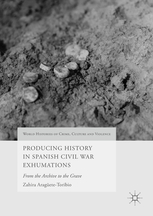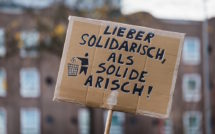
 In this timely volume, Zahira Aragüete-Toribio examines civil society forensic exhumations of Spanish Civil War dead in Extremadura, the region of western Spain where the author grew up. The region, which borders Portugal, saw some of the most intense fighting of the Spanish Civil War. It also witnessed some of the most brutal repression and largest massacres committed by fascist forces, as General Francisco Franco’s Army of Africa and General Juan Yagüe’s “column of death” sought to cleanse the territory of “anti-Spanish” elements and terrorize the civilian population into compliance. It also featured a concentration camp set up by the dictatorship at the end of the war in 1939, which, at its peak, housed upwards of 10,000 Republican prisoners of war.
In this timely volume, Zahira Aragüete-Toribio examines civil society forensic exhumations of Spanish Civil War dead in Extremadura, the region of western Spain where the author grew up. The region, which borders Portugal, saw some of the most intense fighting of the Spanish Civil War. It also witnessed some of the most brutal repression and largest massacres committed by fascist forces, as General Francisco Franco’s Army of Africa and General Juan Yagüe’s “column of death” sought to cleanse the territory of “anti-Spanish” elements and terrorize the civilian population into compliance. It also featured a concentration camp set up by the dictatorship at the end of the war in 1939, which, at its peak, housed upwards of 10,000 Republican prisoners of war.
Spanish exhumations of Civil War dead partake in a far broader trend. Reburials of both famous and anonymous corpses have played an increasingly central role in recent political transitions throughout Europe and beyond. Like mass grave exhumations in Cyprus, Bosnia, and Herzegovina, the recovery of Spanish war dead follows strict scientific and legal protocols. And like the initiatives in the former Soviet Union, they are explicitly political projects, aimed at redefining the imagined national community. But unlike their European colleagues, Spain’s efforts to recover the missing are conducted entirely by civil society organizations, with hardly any coordination with or support from state or United Nations authorities.
Against the grain of human rights literature that often portrays exhumations as extracting history directly from mass graves, Aragüete-Toribio’s careful ethnography shows how forensic excavations, archival research, and family testimonies intersect to produce new ways of knowing the past. This is a multidirectional process, with emotive personal memories, documents generated by fascist bureaucrats, and scientific data converging to enable new interpretations of the past and new communities in the present.
The book is roughly organized around the exhumation process itself, beginning with the pre-excavation research in archives, through the field work of archaeologists, and through the post-forensic commemorative acts. After an introductory chapter discussing the book’s themes, the book begins with two chapters describing the broader context in which exhumations take place. Chapter 2 focuses on how judicial categories influence the historical narratives that emerge from Spanish mass grave exhumations. Focusing on the investigations into the crimes of the Franco dictatorship launched by Judge Baltasar Garzón in 2008, Aragüete-Toribio shows how local testimonies, historical analysis, and archival materials are read across international human rights categories to construct new public historical frameworks. Garzón’s investigation, however, would come to an abrupt end when the Spanish Supreme Court ruled that the magistrate had exceeded his mandate. Spain’s Attorney General subsequently warned investigating judges against taking similar actions, which they declared a violation of the country’s 1977 Amnesty Law. Even as the judicial process was terminated, though, Aragüete-Toribio shows how its legal categories continued to shape the organization and interpretations of mass grave exhumations.
She develops this analysis further in Chapter 3 by demonstrating the constant cross-referencing between the archive and the grave entailed in producing historical narratives about the Franco dictatorship. In Extremadura, an organized, network of historians in and outside of the regional university had already organized research projects aiming to counter the silences and distortions of Francoist narratives long before the advent of forensic exhumations. Yet Aragüete-Toribio shows how exhumations transformed historical epistemologies, bringing together historians and civil society actors in new configurations. On the one hand, she shows how archival materials facilitate new forms of private and public memory, as documentation validates victim testimony and allows it to circulate through the public sphere. On the other hand, she shows how historians and civil society actors work to flesh out “cold” documents, by infusing them with the emotional testimonies of those directly affected by fascist violence. What emerges is a dialectical relationship between the archive and the mass grave.
The following three chapters hone in on the practices of forensic science in two different archaeological projects. Chapter 4 deals with the excavation of unknown human remains from a concentration camp for Republican POWs in the village of Castuera. Chapter 5 looks at an exhumation in Puebla de Alcocer, where the general identity of the victims is known, even though positive identification could not be made. Together, these chapters focus on how the material presence of human bones and their associated objects triggers complex collaborations between scientific experts and laypersons at the mass grave to rewrite the history of the conflict. Aragüete-Toribio shows how the emergence of new material objects often triggers the public testimony of local villagers which, in turn, may dramatically alter the meanings ascribed to scientific findings. In the case of the unknown human remains in Castuera, the materiality of the bones provoked new kinds of historical claims, enabling activists to demand public recognition for their own right to produce history in an ideological landscape dominated not only by Francoist narratives, but also by competing political projects amongst leftist groups. For instance, at one point, the activists organizing the excavation object strongly to the presence of a Socialist politician at the gravesite, proceeding to assert their own ownership over the exhumed remains. If the unknown remains in Castuera catalyzed new ideological struggles, the mass grave exhumation in Puebla de Alcocer shows how the discovery of these remains can also constrain the emergence of new narratives. When only eight of the expected twenty-six bodies emerge from the mass grave, the exhumation provokes great anxieties for relatives, requiring them to rework of local memories of the violence in light of the material realities discovered through the scientific intervention. Chapter 6 continues the analysis of these excavations by examining the affective contexts of mass grave exhumations. Both of the forensic projects examined became powerful sites for cultivating emotive histories and opening up a space for publicly denouncing the crimes of the dictatorship. Aragüete-Toribio shows how families cultivate a sense of intimacy with the dead through interactions with bones, objects, and archival documents. Beyond reestablishing social bonds between the living and the dead, these affective practices also allow families of the disappeared to claim a place themselves and their disappeared kin within a broader, socially recognized history.
Expanding beyond the immediate circle of kin and activists organizing the search for the missing, Chapter 7 focuses on the ways rituals of reburial forge new imagined communities united through the act of mourning the deceased. Aragüete-Toribio continues to highlight the importance of material remains, noting how, in the absence of the dead body, relatives’ demand for space in municipal cemeteries can be denied by local politicians. Even when new communities are solidified through in mortuary rites commemorating those who died resisting fascism, there remain strong generational and ideological tensions, as competing groups of mourners struggle to define the meanings of the dead through the presence or absence of religious and political symbols during the reburial ceremony.
Taken together, the book represents a substantial contribution to understanding how archival materials – broadly conceived to include state documents, oral testimonies, and excavated materials – function to enable and constrain the possibilities of certain kinds of historical statements in the public sphere. While Aragüete-Toribio provides a tremendously detailed ethnographic account of Spanish mass grave exhumations, at times the book leaves provocative themes documented but undertheorized. While the book does an admirable job tracing the tensions generated by exhumations, both between supporters and opponents of recovering the missing and especially amongst activists, scientists, and relatives supporting efforts to recover the missing, the implication of these tensions on the varied historical and political projects inspired by the search for the missing remains underexplored. Aragüete-Toribio also carefully attends to the regional specificities of Extremadura, including in a remarkable vignette in the book’s introduction where the author discusses the Civil War for the first time with her own grandmother. Yet how the local and regional dynamics affect the forensic production of history in ways that differ from similar movements elsewhere in Spain and Europe is not always fully elaborated.
Despite these minor faults, Aragüete-Toribio’s book remains a major ethnographic contribution to the ways forensic science prompts new historical imaginations in the twenty-first century. Anthropologists, human rights scholars, and anyone interested in the increasingly contested terrain of historical production will find many provocative insights throughout this compelling text.
Reviewed by Jonah S. Rubin, Knox College
Producing History in Spanish Civil War Exhumations: From Archive to Grave
By Zahira Araguete-Toribio
Publisher: Palgrave Macmillan
Hardcover / 257 pages / 2017
ISBN: 978-3319612690
To read more book reviews click here.
Published on October 2, 2018.




